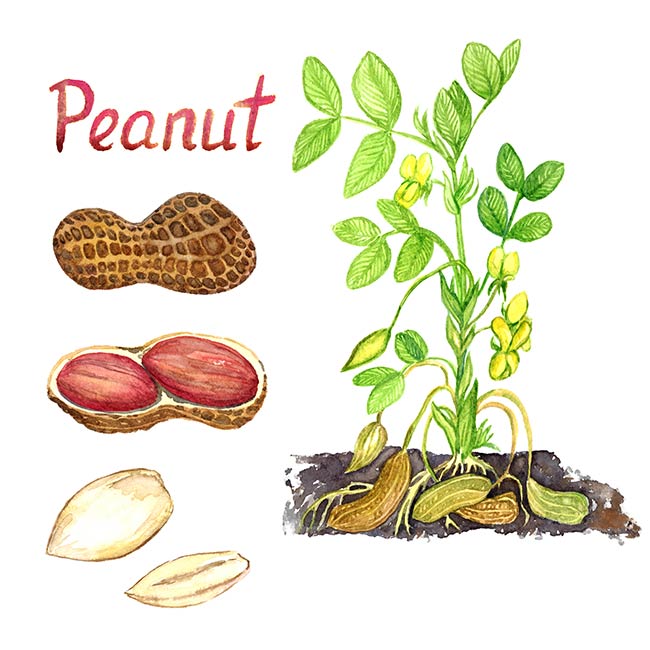How to Grow Peanuts In or out of Containers

Make sure to like Living Green and Frugally on Facebook, Shop at amazon to help support my site and explore our PINTEREST BOARDS for innovative ways you can become self-sufficient.
Peanuts are fairly unique in the nut world, as they grow underground and are not produced by large trees. That’s because they are not actually nuts at all, but legumes like beans or peas.Peanuts are very high in protein, more than other legumes or nuts. They also have fiber, magnesium, zinc and vitamin E. Unfortunately, there is a relatively high incidence of peanut allergies these days which has put the peanut slightly out of favour with the general populous.
Peanuts, a versatile and nutritious legume, are a fun and rewarding crop to grow in your garden. Whether you have a spacious backyard or a small balcony, peanuts can be grown successfully both in the ground and in containers. This guide will walk you through the steps of growing peanuts, ensuring you have a bountiful harvest.
Why Grow Peanuts?
Peanuts are rich in protein, healthy fats, vitamins, and minerals. Growing your own peanuts allows you to enjoy fresh, pesticide-free nuts and offers the satisfaction of cultivating a unique crop. Additionally, peanuts improve soil health by fixing nitrogen, benefiting other plants in your garden.
Growing Peanuts in Containers
Materials Needed
- Peanut seeds (raw, unroasted)
- Large containers (at least 12 inches deep and wide)
- Potting soil
- Compost
- Watering can
- Fertilizer (optional)
View this post on Instagram
Steps
- Choose the Right Container: Select a container with good drainage holes. Peanuts require ample space for their roots and developing pods.
- Prepare the Soil: Use a well-draining potting mix enriched with compost. Peanuts thrive in sandy or loamy soil with a slightly acidic to neutral pH (6.0-6.5).
- Plant the Seeds:
- Soak peanut seeds overnight to enhance germination.
- Plant the seeds 1-2 inches deep, spacing them 4-6 inches apart.
- Cover the seeds with soil and water thoroughly.
- Provide Adequate Light: Place the container in a sunny location. Peanuts need at least 6-8 hours of sunlight daily.
- Water Regularly: Keep the soil consistently moist but not waterlogged. Water deeply to encourage deep root growth.
- Fertilize Sparingly: If desired, use a balanced fertilizer sparingly. Too much nitrogen can inhibit pod formation.
- Monitor Growth: Peanuts will germinate in 1-2 weeks. They grow slowly initially, then develop yellow flowers, which will turn into pegs that push into the soil to form pods.
- Harvesting: Peanuts are ready to harvest 120-150 days after planting, when the leaves turn yellow. Carefully dig up the plant and hang it to dry for a few days. Once dry, remove the peanuts from the roots.
Growing Peanuts in the Ground
Steps
- Select the Planting Site: Choose a sunny spot with well-draining soil. Peanuts prefer sandy or loamy soil.
- Prepare the Soil: Work compost into the soil to improve fertility. Ensure the soil is loose to allow the pegs to penetrate easily.
- Plant the Seeds:
- Soak seeds overnight.
- Sow the seeds 1-2 inches deep and 6 inches apart in rows spaced 2-3 feet apart.
- Cover with soil and water well.
- Care for the Plants:
- Water regularly, keeping the soil moist but not waterlogged.
- Mulch around the plants to retain moisture and suppress weeds.
- Hill soil around the base of the plants once they start flowering to support the developing pegs.
- Monitor and Maintain: Watch for pests and diseases. Use organic pest control methods if necessary.
- Harvesting: When the plants’ leaves turn yellow, it’s time to harvest. Carefully dig up the plants, shake off excess soil, and let them dry in a warm, dry place.
View this post on Instagram
Tips for Successful Peanut Growing
- Timing: Plant peanuts after the last frost date in spring, as they need warm soil to germinate.
- Variety: Choose a peanut variety suited to your climate. Valencia and Spanish peanuts are good for shorter growing seasons.
- Pests: Keep an eye out for common pests like aphids and caterpillars. Use organic insecticides or companion planting to deter them.
- Crop Rotation: Rotate peanuts with other crops to prevent soil-borne diseases and maintain soil health.
Growing peanuts can be a delightful and educational experience. With the right care and attention, you can enjoy a generous harvest of homegrown peanuts, whether you grow them in containers or directly in your garden. Happy planting!